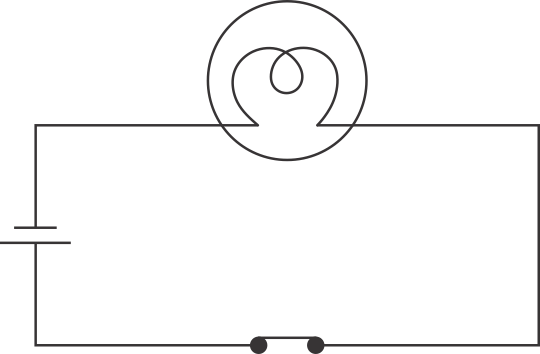Q1. A switch is a device that is :
Solution
A switch is a device that is used to allow current to flow in the circuit or in an electrical appliance and to cut it off when desired.
Q2. Give two uses of electromagnets.
Solution
Two uses of electromagnets are:
Electromagnets are used in the construction of a large number of devices like electric bells, loudspeakers, electric motors, electric fans, etc.
Electromagnets are used by doctors to remove tiny iron pieces from the eyes of a person (which may have fallen into the eyes accidently).
Q3. How a fuse wire prevents damages to electrical circuits and possible fires?
Solution
There is a maximum limit for the current to flow through the circuit. If accidentally, the current exceeds the safe limit, the wire may become overheated and may cause fire. In this case, the fuse wire blows off and breaks the circuit thus prevents the damages to electrical circuit.
Q4. Name the factors on which amount of heat produced in wire depends.
Solution
The heat produced in wire depends on its material, length, and thickness.
Q5. Full form of MCB is :
Solution
MCB stands for Miniature Circuit Breaker.
Q6. The amount of heat produced in a wire depends on its :
Solution
The amount of heat produced in a wire depends on its material, length and thickness.
Q7. How can we say that the electric circuit is complete? What happens when the circuit is complete?
Solution
When the switch is in 'ON' position, the circuit from the positive terminal of the battery to the negative terminal is complete. The circuit is then said to be closed and the current flows throughout the circuit instantly.
Q8. What do you mean by an electromagnet?
Solution
Electromagnet is a temporary magnet which behaves like a magnet only when electric current flows through it. When the electric current is switched off it looses its magnetism.
Q9. The magnetic field produced due to the current passing through a conductor is proportional to the ______.
Solution
The magnetic field produced due to the current passing through a conductor is proportional to the electric current.
Q10. An electric bulb works on the principle of :
Solution
An electric bulb works on the principle of heating effect of electric current.
Q11. Why is it that same current flowing through the tungsten filament of an electric bulb produces enormous heat but almost negligible heat is produced in the connecting wires of the bulb?
Solution
This is because of the fact that the fine tungsten filament has a very high resistance whereas copper connecting wires have very low resistance.
Q12. Electromagnets are based on the :
Solution
Electromagnets are based on the magnetic effect of current.
Q13. What is a circuit diagram? What is its use?
Solution
A diagram which tells us how the various components in a circuit have been connected by using the electrical symbols of the components, is called a circuit diagram. We usually represent an electric circuit by its circuit diagram because it is much easier to draw a circuit diagram by using symbols.
Q14. An electric circuit is said to be ______ when the switch is in ON position.
Solution
An electric circuit is said to be closed and complete when the switch is in ON position.
Q15. Identify the given figure. Why we should not switch on the current for more than few seconds through it?


Solution
The given figure is an electromagnet. We should not switch on the current for more than few seconds through an electromagnet because the electromagnet weakens the cell quickly if left connected.
Q16. The direction of magnetic field lines is taken as:
Solution
The direction of magnetic field lines is taken as North to South.
Q17. Give two advantages of CFLs.
Solution
Two advantages of CFLs are:
(i) CFLs do not have filaments and do not work on heating effect of current. So, they do not waste electricity by producing heat.
(ii) CFLs can be fixed in ordinary bulb holders which are used for traditional, filament-type electric bulbs.
Q18. Draw a circuit diagram for the following electric circuit: 

Solution

Q19. Describe an activity to make an electromagnet.
Solution
(i) Take a long piece of insulated wire and an iron nail. (ii) Wind the wire tightly around the nail. (iii) Connect the free ends of the wire to the terminals of a cell through a switch. (iv) Place some pins on or near the end of the nail and switch on the current. The pins cling to the tip of the nail. (v) The coil behaves like a magnet till the current flows through it.
Q20. What are the causes of short circuiting and overloading?
Solution
The short circuiting may occur due to the touching of live wire and neutral wire directly. Overloading may be due to the flow of excessive current when many devices are connected to a single socket.
Q21. Give two advantages of electromagnets over permanent magnets.
Solution
1. The magnetism of an electromagnet can be switched on or switched off as desired. This is not possible with a permanent magnet.
2. An electromagnet can be made very strong by increasing the number of turns in the coil, and by increasing the current passing through the coil. On the other hand, a permanent magnet cannot be made so strong.
Q22. What happens when a large amount of current passes through a wire?
Solution
If large amount of current passes through a wire, the wire may become so hot that it may even melt and break.
Comments
Post a Comment